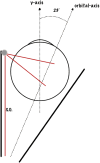Functional anatomy of the orbit in strabismus surgery: Connective tissues, pulleys, and the modern surgical implications of the "arc of contact" paradigm
- PMID: 38243145
- PMCID: PMC11095312
- DOI: 10.1111/joa.14009
Functional anatomy of the orbit in strabismus surgery: Connective tissues, pulleys, and the modern surgical implications of the "arc of contact" paradigm
Abstract
Oculomotricity is a multidimensional domain characterised by a delicate interplay of anatomical structures and physiological processes. This manuscript meticulously dissects the nuances of this interplay, bringing to the fore the integral role of the extraocular muscles (EOMs) and their intricate relationship with the myriad orbital connective tissues as it harmoniously orchestrates binocular movements, ensuring synchronised and fluid visual tracking. Historically, the peripheral oculomotor apparatus was conceptualised as a rudimentary system predominantly driven by neural directives. While widely accepted, this perspective offered a limited view of the complexities inherent in ocular movement mechanics. The twentieth century heralded a paradigm shift in this understanding. With advances in anatomical research and imaging techniques, a much clearer picture of the gross anatomy of the EOMs emerged. This clarity challenged traditional viewpoints, suggesting that the inherent biomechanical properties of the EOMs, coupled with their associated tissue pulleys, play a pivotal role in dictating eye movement dynamics. Central to this revised understanding is the "arc of contact" paradigm. This concept delves deep into the mechanics of eye rotation, elucidating the significance of the point of contact between the EOMs and the eyeball. The arc of contact is not just a static anatomical feature; its length and orientation play a crucial role in determining the effective torque generated by a muscle, thereby influencing the amplitude and direction of eye rotation. The dynamic nature of this arc, influenced by the position and tension of the muscle pulleys, offers a more comprehensive model for understanding ocular kinematics. Previously overlooked in traditional models, muscle pulleys have now emerged as central players in the biomechanics of eye movement. These anatomical structures, formed by dense connective tissues, guide the paths of the EOMs, ensuring that their pulling angles remain optimal across a range of gaze directions. The non-linear paths resulting from these pulleys provide a more dynamic and intricate understanding of eye movement, challenging two-dimensional, linear models of orbital anatomy. The implications of these revelations extend beyond mere theoretical knowledge. The insights garnered from this research promise transformative potential in the realm of strabismus surgery. Recognising the pivotal role of muscle pulleys and the "arc of contact" paradigm allows for more precise surgical interventions, ensuring better post-operative outcomes and minimising the risk of complications. Surgical procedures that previously relied on basic mechanical principles now stand to benefit from a more nuanced understanding of the underlying anatomical and physiological dynamics. In conclusion, this manuscript serves as a testament to the ever-evolving nature of scientific knowledge. Challenging established norms and introducing fresh perspectives pave the way for more effective and informed clinical interventions in strabismus surgery.
Keywords: anatomy; connective tissue; eye movements; oculomotor muscles; orbit; rectus muscle pulleys; regional; strabismus.
© 2024 The Authors. Journal of Anatomy published by John Wiley & Sons Ltd on behalf of Anatomical Society.
Conflict of interest statement
The authors declare that they have no conflict of interest.
Figures







Similar articles
-
Location and stability of rectus muscle pulleys. Muscle paths as a function of gaze.Invest Ophthalmol Vis Sci. 1997 Jan;38(1):227-40. Invest Ophthalmol Vis Sci. 1997. PMID: 9008649
-
Evidence for fibromuscular pulleys of the recti extraocular muscles.Invest Ophthalmol Vis Sci. 1995 May;36(6):1125-36. Invest Ophthalmol Vis Sci. 1995. PMID: 7730022
-
Evidence supporting extraocular muscle pulleys: refuting the platygean view of extraocular muscle mechanics.J Pediatr Ophthalmol Strabismus. 2006 Sep-Oct;43(5):296-305. doi: 10.3928/01913913-20060901-05. J Pediatr Ophthalmol Strabismus. 2006. PMID: 17022164 Free PMC article. Review.
-
Evidence for active control of rectus extraocular muscle pulleys.Invest Ophthalmol Vis Sci. 2000 May;41(6):1280-90. Invest Ophthalmol Vis Sci. 2000. PMID: 10798641
-
The Role of Extraocular Muscle Pulleys in Incomitant Non-Paralytic Strabismus.Middle East Afr J Ophthalmol. 2015 Jul-Sep;22(3):279-85. doi: 10.4103/0974-9233.159698. Middle East Afr J Ophthalmol. 2015. PMID: 26180464 Free PMC article. Review.
Cited by
-
Effects of modified Yokoyama surgery combined with medial rectus muscle recession on esotropia in highly myopia athletes.World J Clin Cases. 2025 Jul 26;13(21):104918. doi: 10.12998/wjcc.v13.i21.104918. World J Clin Cases. 2025. PMID: 40726921 Free PMC article.
References
-
- Beisner, D.H. (1971) Reduction of ocular torque by medial rectus recession. Archives of Ophthalmology, 85, 13–17. - PubMed
-
- Clark, R.A. & Demer, J.L. (2002a) Effect of aging on human rectus extraocular muscle paths demonstrated by magnetic resonance imaging. American Journal of Ophthalmology, 134, 872–878. - PubMed
-
- Clark, R.A. & Demer, J.L. (2002b) Rectus extraocular muscle pulley displacement after surgical transposition and posterior fixation for treatment of paralytic strabismus. American Journal of Ophthalmology, 133, 119–128. - PubMed
Publication types
MeSH terms
LinkOut - more resources
Full Text Sources

